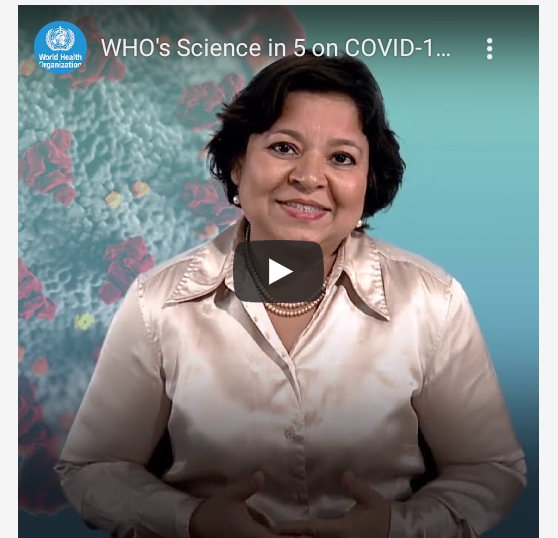Are the symptoms of COVID-19 different in children?
Are the symptoms of COVID-19 different in children? WHO’s Dr. Maria Van Kerkhove explains in Science in 5.
I found this section on World Health Organization‘s site. I found it very useful especially at this time the second wave of Covid-19 is ravaging the world. There are important things parents and caregivers should be aware of in the spread of Covid-19 and the symptoms in Children. WHO’s Dr. Maria Van Kerkhove has explained all of these in their podcast called Science 5.

Dr. Maria Van Kerkhove (WHO’s Doctor)
Are the symptoms of COVID-19 different in children?
These are the excerpts:
Are the symptoms of COVID-19 different in children? Do the new variants impact children differently? What can parents do to keep children safe from COVID-19?
There two people in this Podcast. One person is Vismita Gupta-Smith. He is the one asking the WHO’s doctor all the questions. The second person is the doctor, Dr. Maria Van Kerkhove. who gave answers to all the questions.
You may also like to read:
Covid-19 Has 7 Spirits. It Is No Longer The Virus That Kills
Here is the Transcript of the Podcast:
Vismita Gupta-Smith: We hear a lot about COVID-19 and symptoms in grownups and adults. How does COVID-19 impact children? Welcome to Science in 5. I’m Vismita Gupta-Smith and this is WHO’s conversations in science. We’re talking to Dr. Maria Van Kerkhove today about COVID-19 and children. Welcome, Maria.
Dr. Maria Van Kerkhove: Hi, Vismita. Thanks for having me.
Vismita Gupta-Smith: Maria, tell us about symptoms of COVID-19 in children. Are they any different from grownups, especially in the very young ones?
Dr. Maria Van Kerkhove: So, this is a really important question and we continue to learn about SARS-CoV-2 virus, the virus that causes COVID-19. There are different types of disease presentation based on the age of the person who is infected by this virus. Luckily, children and adolescents tend to have the more mild disease compared to adults. Most people who are infected with the SARS-CoV-2 virus have respiratory symptoms. They start to feel a little bit unwell, they will have a fever, they may have a cough or a sore throat or sneeze.
In some individuals, they may have gastrointestinal symptoms. Others may lose the sense of smell or the sense of taste. Especially in the youngest children, they tend to be more mild, which means they don’t have as many symptoms as adults do. Some children may have gastrointestinal symptoms like diarrhoea or vomiting, but they tend to be more mild. And even most children tend to have asymptomatic infection, which means they don’t have any symptoms at all.
Vismita Gupta-Smith: Maria, we’re hearing a lot about these variants now; what are we seeing? In children, do these variants have different symptoms? Are they impacting children in a different way?
Dr. Maria Van Kerkhove: So, virus variants mean changes in the virus and we are detecting changes in the SARS-CoV-2 virus over time. This is expected. Many of these changes do not have any impact on the virus in terms of its ability to transmit or the disease that it causes. But some variants we call “variants of concern” and these viruses need more study. And scientists are looking at the way the virus transmits, the disease that it causes, and luckily so far, these variants do not tend to cause more severe disease across any age group.
The disease presentation looks the same and the severity looks the same as the other SARS-CoV-2 viruses circulating. In terms of transmission, the virus variant that was identified in the United Kingdom, they noticed an increase in transmissibility across all age groups. This includes increased transmission among younger children as well. In the area where this virus variant was circulating, schools happened to have been open. And the virus that was circulating, also circulated among the students and the faculties in those schools that were open.
So, there’s much study that’s still underway with these virus variants, but the studies in the United Kingdom, for example, do not indicate that the virus specifically targets young children, meaning that it’s not infecting children more than would be likely of other viruses that are circulating in the area.
Vismita Gupta-Smith: Maria, we don’t want to worry mothers, fathers, and caregivers. So, give us some tips about how to keep children, especially the little ones, safe.
Are the symptoms of COVID-19 different in children?
Dr. Maria Van Kerkhove: The best way to keep children safe is about prevention. We want to prevent as many infections as we possibly can all over the world. And it’s about doing it all. The comprehensive package of interventions that you hear us talk about all the time applies to children as well.
Making sure children have clean hands and they wash their hands appropriately with soap and water and sing the songs so that they get enough bubbles and they make sure that those hands are really clean. Or use an alcohol-based rub.
Make sure that they practice respiratory etiquette, where they sneeze into their elbow. Even my littlest one who’s two years old now, will cough and sneeze into his elbow. But these are good habits to be forming for children as they get older. Making sure that if they’re age-appropriate and they follow the local guidance to wear a mask appropriately. With clean hands, make sure that the mask is put on over your ears, covers their nose and their mouth, and that the children don’t touch the outside of their masks.
Make sure that they have clean hands. And then when they take it off, to clean their hands as well. Making sure that you as parents talk to your kids as best you can answer their questions. There’s a lot of confusing information out there and it’s scary. So, find the time to talk to them and answer their questions and alleviate their fear, and make sure that they get good information from you. And probably the most important thing that everybody can do is physical distancing. Outside of your immediate family, make sure that you keep your distance from others. That’s the best way to prevent the spread of SARS-CoV-2.
Vismita Gupta-Smith: Thank you, Maria.
So, parents remember you have a whole toolkit of precautionary measures; make that part of your daily routine and habit for your children. And, also please share this information and other science-based information with your networks of parents. Until next time then. Stay safe, stay healthy, and stick with science.
End of the Podcast
Dear parents, Covid-19 is real. It has killed thousands of people. Protect yourself and protect the children.
News Source: WHO Int



